BIG HORN MEMORIES
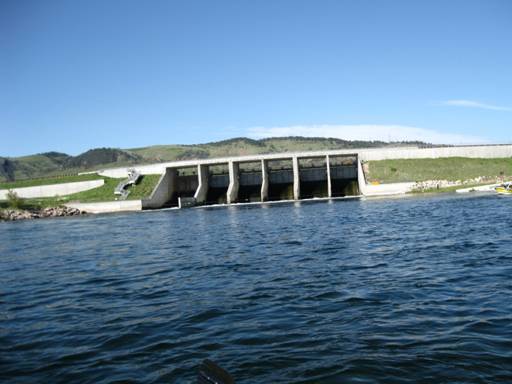
The dam at afterbay on Montana's Big Horn River
The parking lot is filled with boats and anglers, and the roar of the water coming through the afterbay dam mingles together in a cacophony of sounds that assaults the ears and stimulates senses. No matter how many times I launch a drift boat on the Big Horn River below after bay I am always filled with excitement and a sense of awe and appreciation of the privilege of having another day to fish this magnificent fishery.
The drift boat slips away from the shore and it seems that we are afloat in the air rather than on the water. Beneath the bow the bottom falls away revealing a steadily undulating field of green. Dark shadows move above the undulating background, shadows that cause the pulse to increase and the palms to sweat.
More boats push off from shore bristling with fly rods and eager anglers. Fly lines are quickly unfurled and weighted nymphs are dropped into the depths in an attempt to lure one of the trout that are moving above the animated field of green. Strike indicators of various sizes and composition bob along on the surface as eager eyes watch for any sign of movement. It is, to my eyes, a three ring circus composed of drift boats, flailing anglers, 'big bird' indicators; each boat containing a ringmaster firmly anchored to the rowing seat.
The Big Horn River in south-central Montana is a world famous fishery and I have been fortunate to have been able to fish it several times over the years. I feel it safe to say that if you are a person that has a passion for fishing for trout with a fly and you have never fished the "The Horn" you have missed one of the premier angling experiences that any fly fisher can experience.
My experience with the Big Horn goes back to a few years after the river first opened to the general public. My nephew was one of the anglers that had been fishing there since it opened and he suggested that I might enjoy the fishing. That was the beginning of a relationship between me and this world class fishery.
Each trip to the Big Horn starts by making reservations at The Big Horn Trout Shop in Fort Smith. The Big Horn Trout Shop is a long time sponsor of FAOL but my relationship with this fly shop goes back long before my association with FAOL. Hale Harris and Steve Hilbers, the owners of the shop, have been long time acquaintances and I have enjoyed many delightful conversations with them and their wonderful staff.
The Big Horn Trout Shop offers a full service fly shop and excellent accommodations for the visiting anglers. The rooms are well appointed, modern and well maintained. All the rooms have a private bath, TV, air conditioning and wireless internet access is available. They have a common room where anglers can gather and Continental breakfast is provided and is included in the room rate. In the River Run Dining Room they offer an excellent evening meal. Reservations are required and the evening meal is in addition to the room rate. Take it from me, the food is excellent.
The Big Horn Trout Shop is the first place we stop when we get into Fort Smith. We check into our room, check the fishing report, make arrangements for a shuttle, and then we head for the river.
The first day we normally float the upper 3 miles, afterbay to 3 mile access. Over the years I have spent many memorable days on this piece of water. There are several nice flats and when the fish are up on the surface it is one of my favorite places to fish on the Big Horn. While the nymph fishing can result in some excellent fishing I go to the Big Horn to fish the hatches. I normally try to make my first trip in May to take advantage of the warming water and the excellent hatches. The Big Horn has some of the heaviest hatches that I have ever experienced. The midge hatches are the most dependable hatches on the Big Horn. I have been to the river several different times of the year and I have never been on the river when the midges weren't hatching. In the spring of the year the hatches can be extremely heavy, and when they are hatching they can provide some memorable fishing opportunities. Flotillas of midges will often pool in the calm water on the downstream side of the drift boat.
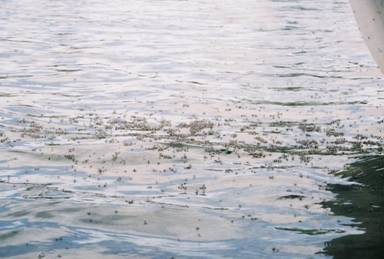
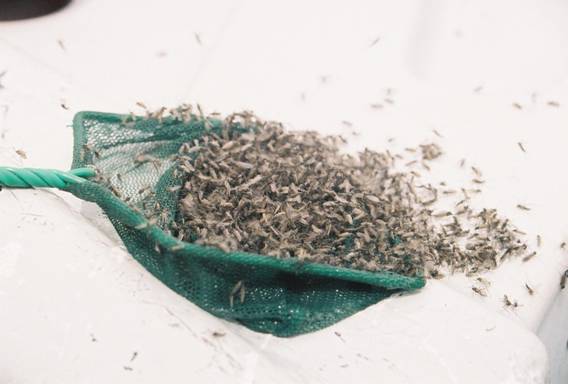
An aquarium net full of midges
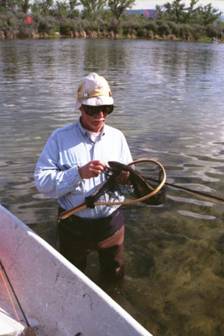 With so many insects on the water the fish can become very picky. One trout may be feeding on emergers while another may be feeding on the adults or even clusters of mating flies. The key to success is to pick out a fish that is working the hatch and then watch that individual fish. Once you have hopefully determined what stage the individual fish is eating you can match it. If you are successful and the fish cooperates the fun really begins.
With so many insects on the water the fish can become very picky. One trout may be feeding on emergers while another may be feeding on the adults or even clusters of mating flies. The key to success is to pick out a fish that is working the hatch and then watch that individual fish. Once you have hopefully determined what stage the individual fish is eating you can match it. If you are successful and the fish cooperates the fun really begins.
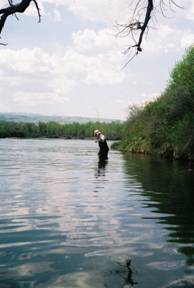
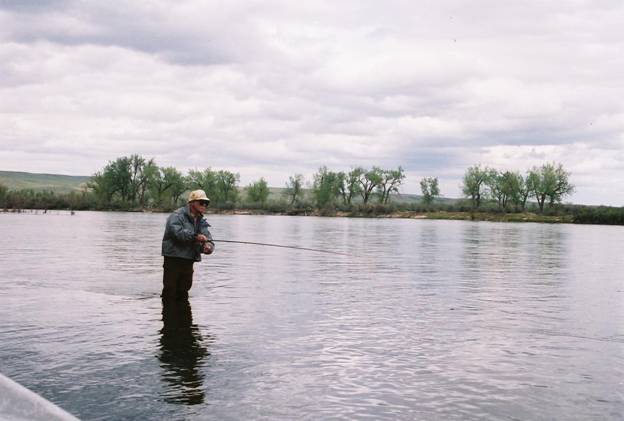
In the spring the weather can be somewhat temperamental but the weather never defeats a crazy fly fisherman. A cloudy overcast day complete with intermittent rain showers may not be as pleasant for the angler but the fish don't seem to mind. In fact, they seem to prefer the cloudy conditions. So we pull out the rain gear and get into the action.
I enjoy the technical fishing that the Big Horn has to offer, and when the bugs are hatching and the fish are moving the hatch I am in fly fishing heaven. Not everyone likes to fish the hatches and there is plenty of action for anglers that like to fish nymphs. The Big Horn River is rich in a variety of aquatic insects; isopods, fresh water shrimp, and aquatic worms are abundant. Streamer fishing can be excellent, especially before the aquatic weeds become too thick or the algae begins to break up and float along in the water column.
On a good day in the spring I am constantly looking for a hatch of spring Baetis. A strong hatch of Baetis will always bring the trout to the surface, and I don't think you have truly lived as a fly fishers until you have experienced a hatch of Baetis on the Big Horn. Unfortunately, at least for the angler, the best Baetis hatches normally occur when the weather is less than ideal. On a clear sunny day you may have a trickle of flies hatching, which are normally not enough to bring most of the fish to the surface, but let the weather turn fowl and suddenly the surface can be covered with hatching mayflies.
I have many memories of memorable days when the sun was playing peek-a-boo between the clouds and intermittent rain showers or even snow flurries [yes, snow flurries in May, after all this is Montana] dotted the surface of the river and hatching Baetis and rising trout mingled with the falling precipitation.
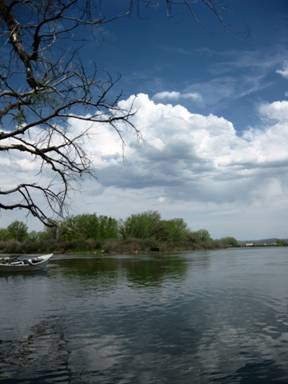 Blue bird days are not without their own pleasures. The warm spring sun is cathartic and it is usually possible to find an ample number of feeding fish quietly sipping emerging midges or drifting pupa struggling in the film. Since the water clarity is normally excellent it is possible to find fish feeding on nymphs, midge larvae and pupa. Sight nymphing to these feeding trout is nearly as exciting as fishing to surface feeding fish, and perhaps even more demanding.
Blue bird days are not without their own pleasures. The warm spring sun is cathartic and it is usually possible to find an ample number of feeding fish quietly sipping emerging midges or drifting pupa struggling in the film. Since the water clarity is normally excellent it is possible to find fish feeding on nymphs, midge larvae and pupa. Sight nymphing to these feeding trout is nearly as exciting as fishing to surface feeding fish, and perhaps even more demanding.
Of course it is always possible to hook up with some fish by drifting a weighted scud/sowbug combination while drifting over the deeper water or wading and casting to the seams below the riffles.
If you are interested in tangling with a big carp you might be surprised to know that there are some really big ones in The Horn. Look for them to be spawning in the backwater areas and then hang on. My nephew likes to stalk those big old rubber lips and we usually spend a few hours on each trip checking out some of the backwater areas that you can find in the stretch of water from 3 mile access to Bighorn. We always have a couple heavier rods rigged up just in case we find a slough with some carp rooting around in the shallows.
While the spring of the year holds a special place for me you can find excellent fishing throughout the season on The Horn. Since The Horn below Yellowtail Dam is like a big spring creek you will find all of the common spring creek hatches on The Horn during the summer and fall. Besides the midges and the spring and fall Baetis hatches the angler can encounter hatches of PMD's, Tricos, Yellow Sally Stoneflies, and Black Caddis. Since The Horn is surrounded by farm and ranch land there are many terrestrial insects available, especially in the late summer and early fall.
One day in late May The Horn had been strangely quiet. We had picked up a few fish on nymphs fished deep but we had not encountered any rising fish. We had not seen a single Baetis and even the midge numbers were small, certainly not heavy enough to bring up any rising trout. The fishing had been slow enough that most of the other boats had left the river and we were debating about heading for the take-out. On the big flat above the 3 mile access we began to see a few fish begin to show. We slipped the anchor and sat in the boat looking upstream. The midges began to appear and soon the surface of the water was covered with hatching and mating midges. Clumps of mating flies quickly attracted the attention of the resident trout. We quickly grabbed our rods and bailed out over the side of the boat. The normally picky Big Horn trout were rising with abandon and for the next hour we hooked one fish right after another. Then, as quickly as it started it was over and the river was again quiet. We looked around and there wasn't another angler in sight. Now that's a Big Horn memory. I hope that you get out and make a few of your own this year.
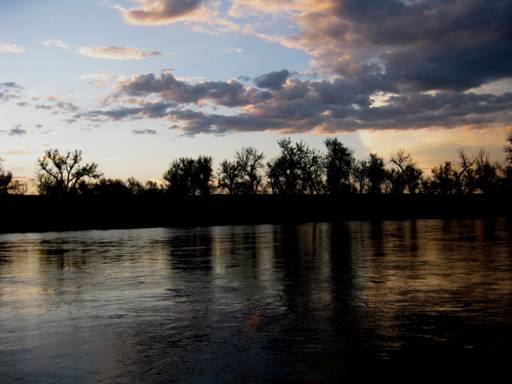
The end of a perfect Big Horn day in late May
For up-to-date information on fishing The Big Horn River check out The Big Horn Trout Shop's website at https://www.bighorntroutshop.com/.
